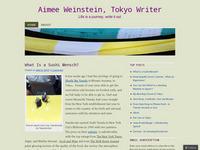- Home » Expat Contests » Education and International Schools - Learning Language at an International School - Japanese For Native and Non-Native Speakers
Learning Language at an International School - Japanese For Native and Non-Native Speakers
By: Aimee Weinstein
As an expat in Japan, learning Japanese is always on my to-do list. I’ve lived in Tokyo for 8 of the past 10 years and am not even close to fluent. Worst of all, I don’t read. My kids, however, are a different story. They make me feel like my great-grandmother circa 1900 on the Lower East Side of Manhattan when she would hand the mail to her kids and ask them to translate the items for her. Don’t laugh; I’ve actually done this. My young teen is a whiz at deciphering the electric bill. What makes the whole concept of learning Japanese interesting for the kids, however, is the International School system in Tokyo.If I had ever thought that we’d still be in Japan ten years after our first visit here, I would have enrolled the kids into a Japanese school at the start. Our first plan was to be here a year, then two years. We went back to the U.S. for two years, but when we came back to Tokyo in 2007, we had no idea how long we would be here, and it seemed too late to throw the kids into a different language environment, though I know now that they probably would have been just fine. At the time, I didn’t know enough about language acquisition or developmental theory to make any other decision than opt for the International School system.
The kids’ first school was the Montessori School of Tokyo (MST). It’s a wonderful place full of encouraging and loving teachers who truly made a difference in my kids’ lives. While committed to student-centered education, the school also allows space, as most international schools do all over the globe, for the formation of a strong community of parents, too. The school is committed to a fairly strict interpretation of Montessori method, with the specially trained teachers and specific materials, and for both kids, through elementary school, this is the way my husband and I wanted the kids to learn. The only problem we found, was the Japanese. Though there was one Japanese speaking teacher and one English speaking teacher in every classroom, there were few formal lessons.
My husband had been learning Japanese from the same tutor since 2003, and though she had never taught kids before, we convinced her that she should start somewhere, and teach our kids. She agreed and thus, the kids started working with their beloved Sensei every week. We started off slow, but now, five years later, the kids work with her once a week but for an hour each. At the beginning, when the kids were little, she taught them to read and write and speak as a Japanese child might learn, using letters as a gateway to understanding language.
Fast forward a few years. My son went through the final year of MST, graduating from grade 6, and started at the American School in Japan (ASIJ). My daughter was not responding well to Montessori method and though we mourned (see more on this topic at musingsofamiddleschoolmom.wordpress.com) we did move her to a much more structured program at the Nishimachi International School (NIS) not far from our home.
Here’s where the Japanese learning element got interesting.
My daughter’s school, while an International school, has always had a strong bilingual program. In addition, a huge percentage of their student body has at least one Japanese parent. For kids like mine who are not even close to bilingual, the school does their best to push them up to as high a level as they can at the outset via an intense first month of specialized, individualized training. When my daughter was finally settled in a regular classroom, it became clear to my husband and me as well as to Sensei, that she would be learning Japanese in a very traditional method used by Japanese schools. She had class every day and learned both Japanese phonetic alphabets at lightning speed, then started composing poetry and essays before moving on to Kanji study. Less than two years later, she is using a regular Japanese school second-grade Kanji book and knows nearly 100 Kanji symbols.
My son, who started at the ASIJ at the same time as my daughter started NIS, also had a short-ish Japanese class every day. He had a wonderful teacher, but a non-native speaker of Japanese. She is Australian and completely fluent, but most of all she could handle a room full of Western kids who are very different temperamentally from a room full of Japanese kids. ASIJ tends to have native Japanese speakers teaching the Japanese kids in their population while they have Westerners teaching Western kids, partially due to classroom management issues. He learned and continues to learn Japanese as a foreign language. That being said, he has beautiful handwriting and great grammar.
Here are the big differences between the two kids: my daughter, age 10, uses Japanese on the playground a lot. She understands most everything being said, she says, but sometimes doesn’t always have the words to respond to her friends the way she’d like. Cheerfully, she adds that it really doesn’t matter though; if she doesn’t know a word, she will say as much as she can in Japanese, and throw in a few English words when necessary. She’s not afraid to just try – to put her Japanese skills to the test anywhere at any time. Her accent is flawless, too, from having been in Japan most of her life. My son, however, is more reticent with his language skills. And while he probably has more vocabulary and more Kanji than my daughter, he uses them less often. That being said, he’s quick to correct her when she makes a grammar mistake or forgets a word and substitutes English. Neither kid is a perfectionist by any means, it’s just that they have different Japanese – hers is more colloquial; his is more technical.
Both kids continue weekly study with their Sensei, who is more of a member of our family after five years of study together. I think it’s more support than learning these days, but if she makes the kids feel confident with their language skills, then I’m all for it.
For us, the International school system in Japan has given our kids the gift of a private education, which they may not have had if we had stayed in our little corner of suburban Washington DC. While their Japanese skills aren’t even close to native level, both kids have terrific abilities and have learned so much – albeit differently – at their International schools. The schools even with their differences, are one of the best parts of being an expat.
Grab a badge that links to this contest entry!
 Copy and paste code to display this Contest Entry Badge:
Copy and paste code to display this Contest Entry Badge:Contest Comments » There are 7 comments

Kendra wrote 12
years ago:
Excellent and insightful!

Trisha wrote 12
years ago:
Fascinating post, Aimee! It's cool you can see the differences side-by-side with your kids. I remember, in learning Spanish, that while I learned a good amount of the language in my ten years of schooling, prior, but I truly learned to _speak_ in the four months I spent living in the country. That said, I'm shy to use it, still, around native speakers. I wasn't when I was over in the culture, though, nor when I was in Mexico. Thank you for sharing your experiences!

Ginny wrote 12
years ago:
This post really got me thinking about different ways of learning. You have some wonderful insights into an aspect of expat life that is often overlooked. Thank you!

Bruce wrote 12
years ago:
Interesting, as usual.

Michele wrote 12
years ago:
Having just visited with Aimee, I saw first hand the efficiency of her 10 year old--freely speaking, comfortable with the language and the older child not quite so comfortable conversationally, but adept at reading. But they were both so eager to work with their tutor. Aimee's analysis is spot on and perhaps the approach so often used in the USA which results in many foreign language students feeling at ease grammatically and reading, but not in conversation is a result of the age of the student and the native or non native speaking teacher. Aimee offers an insightful analysis of the situation.

Melyssa wrote 12
years ago:
I am an English Teacher in Tokyo, though originally from California, and this post was very interesting to me. I've only taught in two japanese schools, one public and one private, so I don't know a lot about international schools. I've always wondered how kids who are half Japanese or kids like yours who are not (I think?), can learn both English and Japanese. Often, it seems like one or the other. It's great your kids are able to study it and progress at school and your tutor sounds like a great teacher...I need her too! haha. Thank you for this insightful post. I really enjoyed it. Melyssa

Wendy wrote 11
years ago:
Thx for sharing your experience. I would like to update the Japanese class info in ASIJ (American School in Japan). ASIJ has changed its Japanese class to 1 1/2 hour daily and all the classes are taught by Native Japanese teachers from 2013. We moved from U.S last year and my sons are 2nd and 4th grade. After being in the program for one year, they speak very basic Japanese, like ordering in a restaurant. They tried to enroll in the LEGO after school program ROBOTICS CLASS but after one tryout class, they said their Japanese is not good enough to understand the instructor nor can they read the instruction. As they really want to be in the LEGO program, I am finding other source for them to improve their Japanese.
 Aimee Weinstein is an American expat living in Japan. Blog description: Life is a journey; write it out.
Aimee Weinstein is an American expat living in Japan. Blog description: Life is a journey; write it out.





